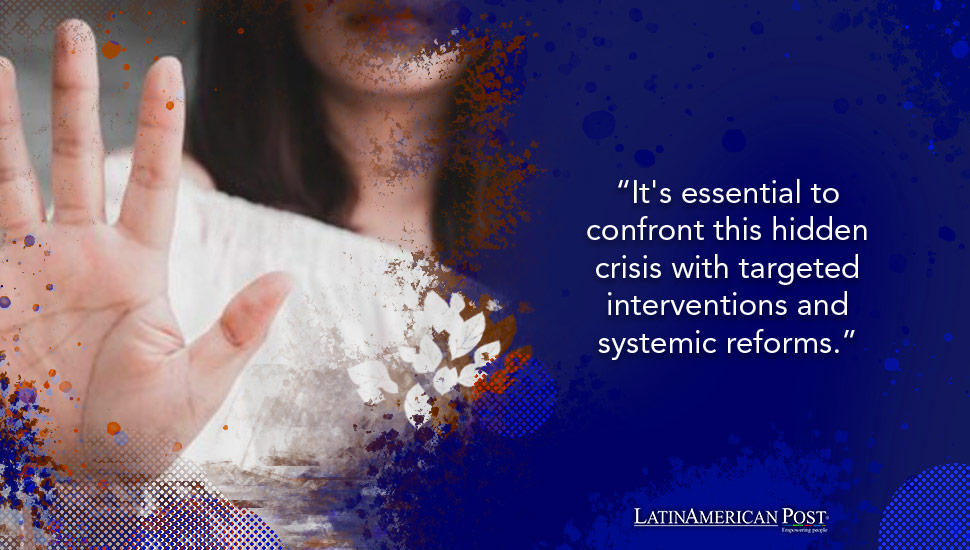Ending the Silence: Addressing Feminicide Suicides in Latin America

In Latin America, “feminicide suicides”—where women take their lives to escape cycles of violence—remain largely unrecognized. It’s essential to confront this hidden crisis with targeted interventions and systemic reforms.
In Latin America, the scourge of feminicide presents a multifaceted crisis that extends beyond direct acts of violence. An alarming dimension, often overlooked in the broader dialogue on gender-based violence, is the phenomenon of “feminicide suicides.” This term refers to the tragic choices made by women who, feeling trapped in relentless cycles of abuse, see suicide as their only escape. These deaths are a direct consequence of systemic violence against women, yet they are rarely accounted for in official statistics or public discourse.
Sandra Gallegos, a criminal analyst and lawyer specializing in gender violence, sheds light on this dire issue. In regions across Latin America, the number of feminicide suicides at times surpasses the number of women killed by direct violence. This stark reality underscores the urgent need for a comprehensive strategy that not only seeks to prevent direct attacks but also addresses the conditions that drive women to such despair.
Understanding the Scope and Impact
The invisibility of feminicide suicides in statistical data and media reporting means that the accurate scale of this crisis is largely unknown. These deaths are often not judicially recognized as femicides because they lack a direct perpetrator of violence despite the clear link to gender-based abuse. As a result, the families and communities affected by these tragedies are left without justice or the necessary support to deal with their loss and trauma.
Strategic Interventions Needed
To effectively address feminicide suicides, a multifaceted approach is required:
Recognizing and Classifying Feminicide Suicides: The first step is for governments and international bodies to recognize feminicide suicides as a distinct category within the broader context of feminicides. This recognition should be reflected in data collection, research, and policy-making to ensure a comprehensive understanding of the issue.
Enhancing Legal and Social Protections: Legal systems must be equipped to identify and intervene in cases of domestic violence before they escalate to either direct feminicide or suicide. This involves stricter enforcement of existing laws and the creation of new legislation that focuses on prevention, early intervention, and support for those at risk.
Community and Healthcare Initiatives: Local communities, healthcare providers, and social workers play a crucial role in identifying and supporting women at risk of gender-based violence. Training programs that equip these frontline workers with the skills to recognize signs of abuse and provide appropriate interventions can be lifesaving.
Mental Health Support: Comprehensive mental health services are critical. These services should be accessible and tailored to the needs of women who have experienced or are experiencing violence. Support groups, counseling, and crisis intervention services can provide the emotional support needed to help women see alternatives to suicide.
Public Awareness Campaigns: Raising awareness about feminicide suicides through education and media campaigns can help change public perceptions and reduce stigma. These campaigns should highlight the signs of domestic abuse, promote understanding of the resources available, and encourage community solidarity in supporting at-risk women.
Economic Empowerment Programs: Economic dependence on abusive partners often traps women in violent relationships. Programs that provide women with education, vocational training, and financial resources can empower them to leave abusive environments and rebuild their lives independently.
A Call to Action
The tragic reality of feminicide suicides in Latin America is a stark reminder of the deep-seated gender inequalities and pervasive violence that continue to plague the region. Addressing this issue requires targeted interventions and a cultural shift towards greater gender equality and respect for women’s rights.
Also read: Latina Women Deserve Better: Ending the Abortion Access Disparity
By implementing comprehensive strategies that address both the symptoms and root causes of gender-based violence, Latin America can move closer to a future where no woman feels forced to choose suicide as an escape from abuse. This is not just a policy challenge but a moral imperative to affirm the value of women’s lives in every part of society.





